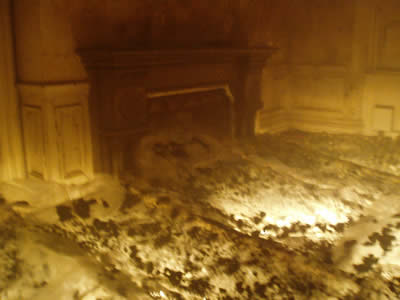
SMOG
NOCTURNE
let
us go then, you and I,
When the evening is spread out against the sky
Like a patient etherised upon a table;
Let us go, through certain half-deserted streets,
The muttering retreats
Of restless nights in one-night cheap hotels
And sawdust restaurants with oyster-shells
…………………………………………..
The
yellow fog that rubs its back upon the window-panes,
The yellow smoke that rubs its muzzle on the window-panes
Licked its tongue into the corners of the evening,
Lingered upon the pools that stand in drains,
Let fall upon its back the soot that falls from chimneys,
Slipped by the terrace, made a sudden leap,
And seeing that it was a soft October night,
Curled once about the house, and fell asleep.
Excerpts from Prufrock.
T S Eliot. 1917
The all encompassing
smoke and fog in the above passages are major characters in London’s
fiction and reality of the last two centuries from high gothic
drama to Dickens to Sherlock Holmes.
The atmospheric conditions re/created in this installation were
inspired by these descriptions both factual, literary and visual
of fogs eternal and spectral presence in the city and its status
as the most infamous Victorian meteorological phenomena. (See
Peter Ackroyd. London:A biography. Vintage.2001. Chapter
47. A foggy day.p431)
The aim was to make hyper real the conditions evoked in the fog-shrouded
paintings of Whistler and Turner’s “Rain wind and
speed”- an expansion of the domesticated fire place into
a haunting microclimate.
Evoking the characteristics of a phantom like smog the interior
experience was intensified with creeping external associations
of darkness, an ever present fear of fire in the history of London
and an ongoing connection between the city and it’s mysterious
underground.
As the fog is described
as a “London particular” the work “Smog Nocturne”
began by piecing together the more specific stories and associations
of this grand Hotel….from the close proximity of the railway
and the era of the romance of rail to the facts of the industrial
revolution and this building in its heyday.
St Pancras Station was the centre for distribution of coal around
the capital fuelling half a million domestic coal fires, not to
mention the burgeoning industrial revolution and its machines
and factories.
In the hotel, coal and water were constantly carried by hundreds
of chambermaids to the guest’s rooms providing fuel for
hot bathtubs. This work is influenced by this alternative history
to that of romanticised opulence - a labour history exposing the
behind the scenes mechanics of luxury, the unknown stories of
those who resided in the back rooms with a view of the station
and its complimentary noise and soot pollution.
However just as today we all breath deep in the invisible “pea-soupers”
of our century, Victorian London’s smog was non-discriminate,
and insidious, - even the best frocks became greyed and the Hotel’s
resident orchestra and jazz band could not drown out the thunder
of the steam trains of the revolution.
Drawing on the mystery
and atmosphere of the site this installation amplifies and reconfigures
these influences and stories within its artifice, displacement
and extension of materials and sound.
Materials:
Coal.
Fibreglass moulded raised flooring on wooden framework.
Under floor rope lighting.
Smoke machine.
Sound: mixed steam train and sauna emissions.
article
Way Station by Hilary Powell
HILARY
POWELL
Hilary
Powell specialises in highly atmospheric installations fusing
materials with theatrical sound and light effects. She chooses
to work in the “junk’ spaces of the city and she focuses
research on the processes of transformation and recycling of such
urban leftovers within her PhD in Cultural Studies at Goldsmiths
College.
She is a member of Luna Nera who share in her interest and passion
for working in derelict or abandoned structures in the urban environment
and is a partner with Dan Edelstyn in Optimistic Productions collaborating
on documentaries that explore these issues..
www.optimisticproductions.co.uk
The
Derelict Sensation
home |

